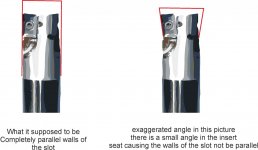Fellow Dude behnod, a couple things...
-First, the second picture shows what looks like a cutter with a damaged insert-pocket. When you are tightening the screw, there should be no rotating-movement of the insert. It should fit firmly against all of the bearing-surfaces of the tool. Has this tool been crashed? If so, throw it away and buy another one...
-Second, your indexable shoulder-milling tools should cut 90* walls. They most often will not produce perfect parallel vertical walls with multiple Z-passes. This is due to several reasons, but one big one is the fact that you're using a "universal" insert, that goes into many different diameter cutter bodies. Like you alluded to in your original post, since there is some helix-angle, it cannot always be a perfect match to the differing cutter body diameters. Because of this non-diameter-specific helix angle, there's going to be some mis-match between Z-passes on vertical walls.
-Third - You cannot cut a "slot" using a full-width cutter, and expect it to be centered-on-location, and with square walls. If other words, you cannot cut a perfect 1/2" slot, with a 1/2" endmill. During a slotting cut, the cutter deflects to the left (on a normal CW-rotation tool) because the teeth at thickest part of the cut (in the direction of travel) are under the greatest load. This means the teeth are under enough force as to deflect the entire tool. Remember - Every action is met by an equal and opposite reaction - and in cutting tools, this means deflection. Endmills both indexable & solid, are not immune to this...
And easy way to visualize this, is to take a slotting-cut in some material. Now, stop, and reverse - running the cutter through the exact same slot. The cutter will only be removing material from one of the vertical walls - that's because during the initial slotting cut, the cutter deflected to the left, and cut past where the slot's left-wall should have been. Likewise, since the cutter deflected to the left, it left material remaining on the slot's right-wall, which should have been cut... When you reverse directions and go back through the slot, the cutter removes the material from the right-wall which should have been cut during the initial slotting-cut, and doesn't even touch the left-wall. Thus, you're left with an over-width slot, with one pretty wall, and one ugly wall...
To get a slot to the correct width, with square walls, on location, you need to use a narrower-than-your-slot endmill. Make the initial slotting cut, then step over, and finish each wall separately. If it's something you really care about too, a spring-pass or two are usually in order as well...






